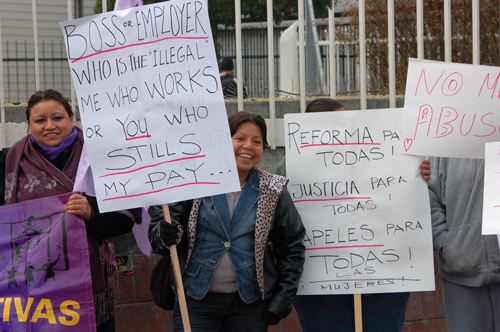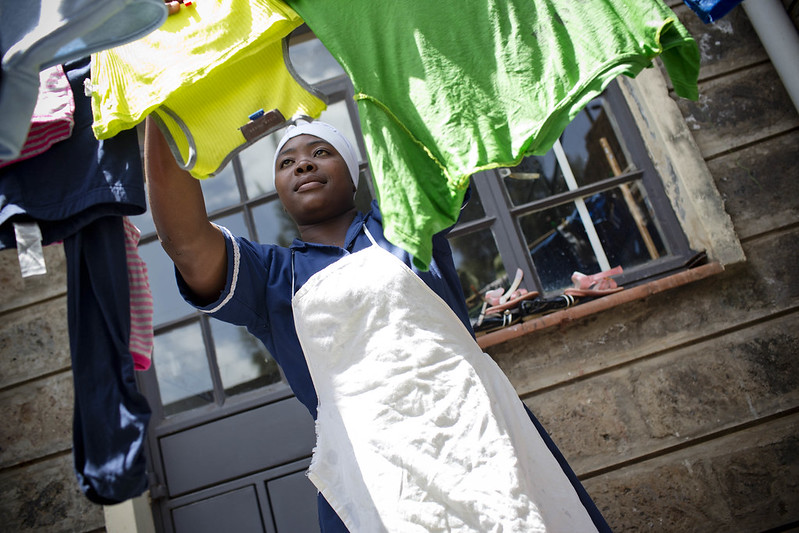Until we recognize and revalue care work, the project of feminism remains imperiled.

Carmen, now 82, came to Los Angeles from Guatemala in the early 1970s. She has worked almost nonstop for the nearly five decades since—first as a nanny, then as a live-in housekeeper, then cleaning houses by the day. When she finally quit cleaning houses in her 70s, after a work injury made it harder for her to get around, she dedicated herself to informal sales.
Over time, she became a U.S. citizen, paid her taxes, and volunteered with several rights organizations. As her economic situation also improved, she was able to cut back on the number of days she worked each week, from seven, to six, to five, and now to three.
These days, Carmen sells clothing that she purchases downtown and delivers to buyers in other parts of the city. Rather than living on the retirement savings she was never able to accrue, or even staying home and sheltering from a virus that is most deadly for people her age, she gets on multiple buses, protected only by a face mask and plastic gloves. In contrast, Carmen’s last long-term employer—who is about the same age—retired, sold her house, and moved closer to her grandchildren.
The obvious distance between Carmen’s situation and that of her former employer belies their shared predicament: the devaluation of care work and its putative assignment to women. In this scenario, the female employer “succeeded” because she could rely on the labor of an immigrant woman—but this arrangement leaves unchallenged the current status of care work in our society.
Papering over the real issue, such short-term solutions merely delay a necessary reckoning. Until we recognize and revalue care work, the project of feminism remains imperiled. A truly intersectional feminism needs to confront both the gendered inequities of our system and the ways these are refracted through race.
In the never-ending time loop of this pandemic, the same types of headlines surface again and again: The burden of child care and remote schooling falls predominantly on women; couples are facing increased tensions, often over housework and child care; more and more working mothers have exited the workforce, many permanently.
These stories reflect one of the multiple cultural fault lines that COVID has forced us to confront: the simultaneous importance and devaluation of care work in our society.
Dismissed as “women’s work”—that is, not “really” work—taking care of children, attending to housework, and/or caring for the sick and elderly is both socially and economically invisible labor. It carries little prestige and, for those who do it for a living, very little pay. Yet, as pandemic life and the shrinking economy remind us, it is crucial, demanding labor. Without it, our economy does not function at the household nor at the national level.
The current crisis has made this abundantly clear. Since February 2020, women have left the labor force in startling numbers; by December 2020, there were 2.1 million fewer women in the workforce than in February.
Many lost their jobs, but even within this group, many have opted not to reenter the employment market, citing the burdens of care work. While mothers’ labor force participation fell 3.3 percent between February and September of 2020, the number of men in the work force decreased by only 1.3 percent.

That women remain responsible for care work is not surprising. Even before the pandemic, they performed a disproportionate share of this labor. The impact on women’s professional and economic lives will be disproportionate as well. Aside from loss of income, pressing pause on a career can hamper an individual’s long term professional trajectory. It also postpones her ability to retire and can potentially trap her in an economically dependent relationship.
This burden, enhanced by the pandemic, will prove ruinous to any gains we have made towards women’s economic independence and gender equality in the labor force. More than that, it will hinder economic recovery for the country as a whole. According to the Census Bureau, it was women’s participation that drove recovery after the Great Recession.
But we should not forget the other, often concealed, layer to this story: the workers like Carmen, who in the “before times,” and even now, keep our society running. Certainly, women attend to the lion’s share of domestic tasks, but those with means can avail themselves of help; they can, and do, hire someone to take care of their children and/or assist with household tasks. This does not change the gendered nature of care work, or the untenable juggling act that working women, especially mothers, are expected to perform.
Instead, it shifts the burden to the women of color, who are paid to take over these duties. In large cities like New York and Los Angeles, the majority of these workers are immigrants who exist in the American imagination only as potential threats to the nation. In reality, they are the workers that ensure our country functions.
By performing unrecognized, undervalued labor, they sustain the American Dream—allowing their employers to earn more income, succeed in the paid workforce, and engage in additional leisure and consumption. In other words, middle class lifestyles, or as close as we can approximate them anymore, and the economic system they predicate exist on the backs of these women.
Domestic employment has always been a poorly paid, unappreciated job—not to mention one that leaves individuals vulnerable to sexual, physical, and verbal abuse. Before COVID, the Economic Policy Institute reported, domestic workers earned an average of $12 an hour and were three times as likely to live below the poverty line than others who worked for an hourly wage. Most do not get benefits, like health insurance, and as they are paid in cash, do not have access to retirement savings.

And the situation has only worsened for this already vulnerable group since the pandemic began. According to the National Domestic Workers Alliance (NDWA), 72 percent of domestic workers lost all of their clients at the beginning of April. And, as of September, 36 percent of domestic workers had no jobs, compared to 9 percent before COVID. 74 percent were not compensated by their employers for the loss of work, rendering many unable to pay their rents and uncertain about whether they could afford food in the following two weeks.
I have been researching and writing about immigrant domestic workers for nearly 20 years, and most of the women I’ve met explain that this is the best job available to them. Still, as Carmen’s story and the above numbers indicate, it is far from ideal. Despite working long hours and performing hard, heavy labor, they remain on the margins, always at the brink of economic calamity.
Why should we care? You could argue—and some do—that as immigrants, they are “lucky” to find work, and more importantly, in a country where every individual is responsible for her own well-being, their futures are theirs alone. But this has never been true, and COVID’s reverberations across every part of our lives emphasize just how much everyone’s fates are entwined.
Increased pay and protections for domestic workers (as crystallized in the NDWA’s Bill of Rights) does more than improve the lives of the individual women who labor in this capacity. Certainly, in the short term, a call for better pay might seem to overstretch employers’ already tight budgets, but in the long term, it is a first step toward recognizing the societal and economic value of care work.
Shortchanging poor, immigrant, women of color does not resolve gendered inequality—it merely displaces it, allowing women with racial and economic privilege to disregard it until a crisis like COVID centers it for everyone.
You may also like:





